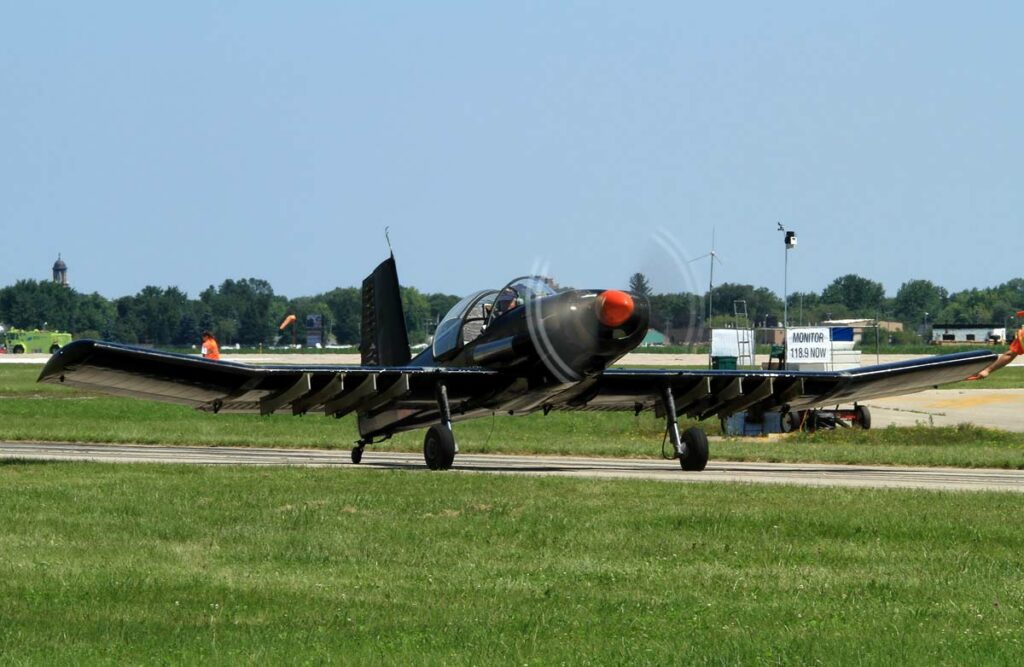The Fletcher FD-25 Defender, a light ground-attack aircraft, was known for its simplicity, robustness, and low-cost operation.
In brief
The Fletcher FD-25 Defender, developed in the mid-20th century, was a light, single-engine, propeller-driven aircraft designed primarily for ground-attack missions. With its straightforward design and efficient performance, it was intended for use in counter-insurgency operations and close air support roles. The FD-25 was characterized by its low operational costs and ease of maintenance, making it suitable for air forces with limited resources. Despite its simplicity, the Defender was capable of carrying a range of armaments, rendering it a versatile tool in various low-intensity conflicts.
The Fletcher FD-25 Defender holds a unique position in the history of military aviation, particularly in light attack and counter-insurgency roles. This article examines the aircraft’s development, design, performance, variants, and operational history.
History of the Development of the Fletcher FD-25 (Defender)
In the context of the Cold War era, there was a growing demand for cost-effective, easy-to-operate aircraft for counter-insurgency operations. Many nations, especially those with limited defense budgets, needed an aircraft that could perform in a variety of roles, including reconnaissance, light attack, and close air support.
The Fletcher Aircraft Corporation launched the FD-25 Defender program to meet this demand. The primary objective was to create a robust, versatile, and economical aircraft that could operate in rugged environments and require minimal maintenance.
The FD-25 Defender first took to the skies in the 1950s. Its development aimed to offer a simple yet effective solution for countries needing a low-cost military aircraft capable of various roles in ground-attack and patrol missions.
The FD-25 Defender emerged as a practical solution during a period when many nations were grappling with guerrilla warfare and needed affordable military equipment. It exemplified the trend towards more specialized, cost-effective military hardware in the post-World War II era.

Design of the Fletcher FD-25 (Defender)
The FD-25 was designed with simplicity and functionality in mind. It featured a conventional layout with a single-engine and high-wing configuration, allowing for excellent visibility and low-speed handling. The aircraft’s dimensions included a length of 7.21 meters and a wingspan of 10.67 meters.
One of the primary advantages was its ease of operation and maintenance, crucial for air forces with limited resources. However, its simplicity also meant limited advanced technology and lower performance compared to more sophisticated aircraft.
The Defender’s design emphasized low-cost production and operation, making it accessible to smaller air forces. It also demonstrated that effective military aircraft could be developed and deployed even with limited resources.
Performance of the Fletcher FD-25 (Defender)
Powered by a single piston engine, the FD-25 had a modest performance profile, with a top speed of around 225 km/h (140 mph) and a range of approximately 480 km (300 miles). It could operate from short and unprepared airstrips.
When compared to contemporary light attack aircraft like the Cessna A-37 Dragonfly, the Defender was less powerful but offered advantages in cost-effectiveness and ease of maintenance.
Variants of the Fletcher FD-25 (Defender)
The FD-25 saw a few variants during its production, each tailored for specific roles. These included models with different engine types and configurations, some with increased payload capacity or modified for specialized missions.
Military Use and Combat of the Fletcher FD-25 (Defender)
The FD-25 Defender was used primarily by smaller air forces for counter-insurgency, border patrol, and light attack missions. It was effective in these roles due to its ability to operate in rugged conditions and carry a range of weapons, including machine guns and light bombs.
The aircraft saw use in various regions, particularly in Southeast Asia and Africa, where its capabilities were well-suited to the operational environment. However, it faced competition from other light attack aircraft and was eventually superseded by more advanced models.
The Fletcher FD-25 Defender stands as a testament to the effectiveness of simple, robust design in military aviation. Its development and operational history highlight the importance of cost-effectiveness and versatility in light military aircraft, particularly in the context of counter-insurgency and patrol missions. While it may not have been the most advanced aircraft of its time, the Defender’s legacy lies in its demonstration that practical and affordable military equipment can significantly impact the dynamics of small-scale conflicts and air force capabilities.
Back to the Special Aircraft section